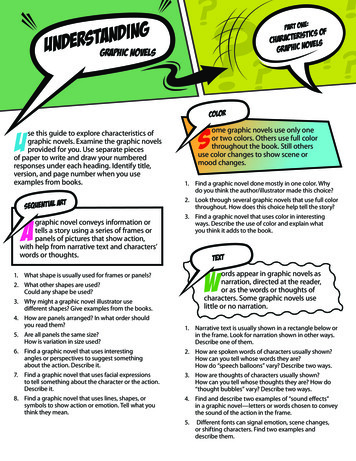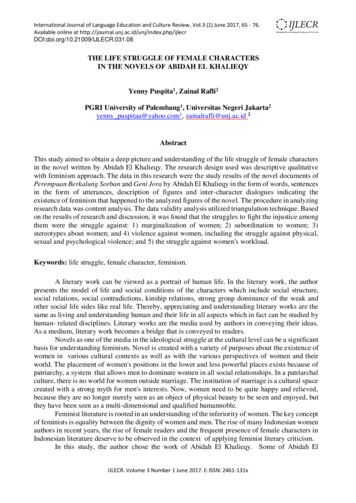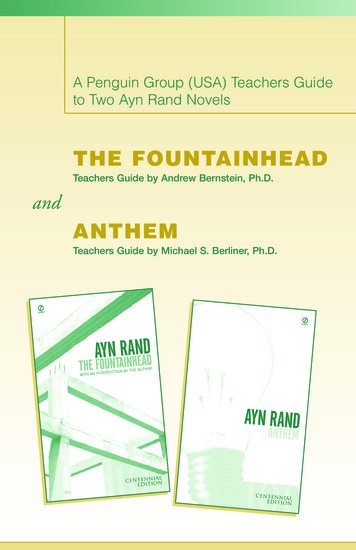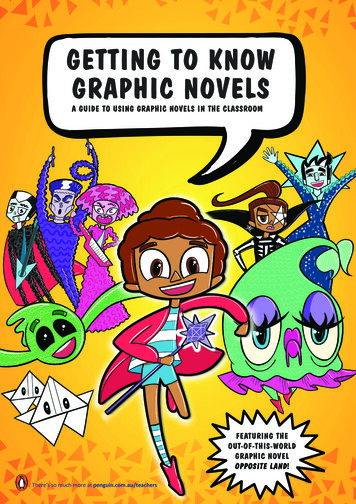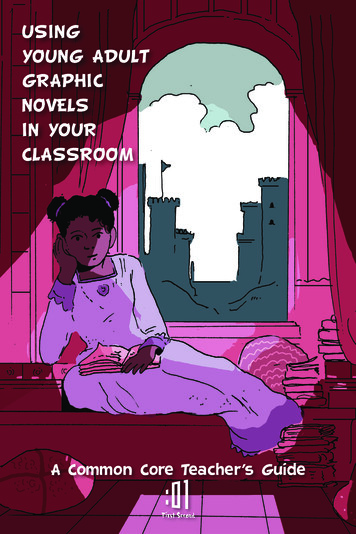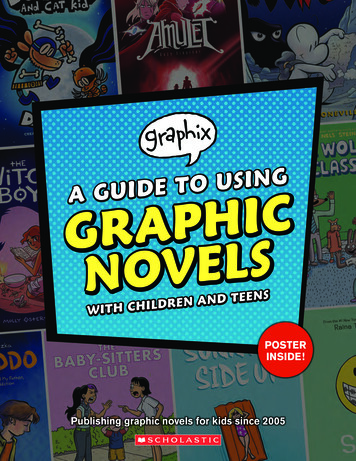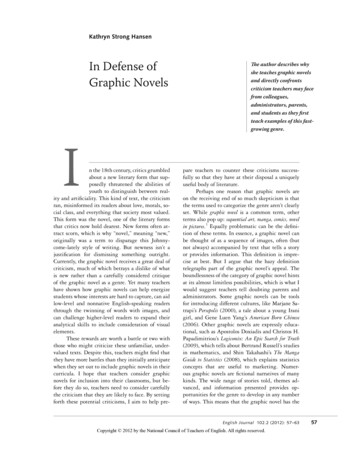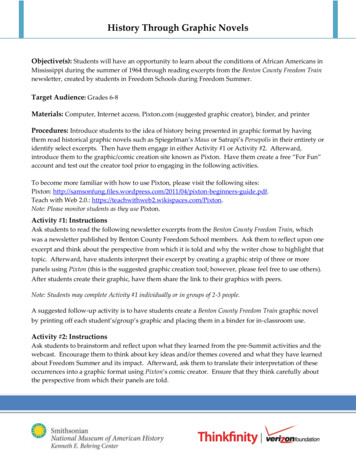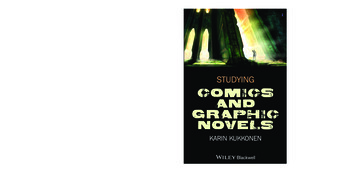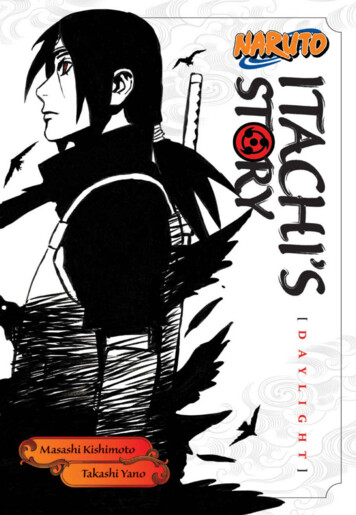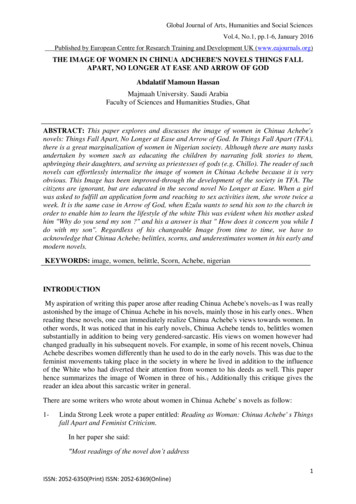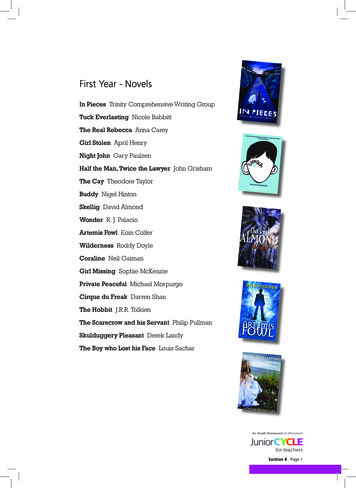
Transcription
First Year - NovelsIn Pieces Trinity Comprehensive Writing GroupTuck Everlasting Nicole BabbittThe Real Rebecca Anna CareyGirl Stolen April HenryNight John Gary PaulsenHalf the Man, Twice the Lawyer John GrishamThe Cay Theodore TaylorBuddy Nigel HintonSkellig David AlmondWonder R. J. PalacioArtemis Fowl Eoin ColferWilderness Roddy DoyleCoraline Neil GaimanGirl Missing Sophie McKenziePrivate Peaceful Michael MorpurgoCirque du Freak Darren ShanThe Hobbit J.R.R. TolkienThe Scarecrow and his Servant Philip PullmanSkulduggery Pleasant Derek LandyThe Boy who Lost his Face Louis SacharSection 4 Page 1
www.juniorcycle.ieResource Pack for Teachers of EnglishSecond/Third Year Prescriptive NovelsTo Kill a Mockingbird Harper LeeJane Eyre Charlotte BrontëThe Dare John BoyneMy Antonia Willa CatherOnce Morris GleitzmanLord of the Flies William GoldingThe Outsiders S.E. HintonThe Wind Singer William NicholsonAnimal Farm George OrwellOf Mice and Men John SteinbeckStone Cold Robert SwindellsShadows on Our Skin Jennifer JohnsonThe Knife of Never Letting Go Patrick NessTrue Grit Charles PortisThe Book of Lost Things John ConnollyNoughts and Crosses Malorie BlackmanTrash Andy MulliganInto the Grey Celine KiernanChalk Line Jane MitchellThe Weight of Water Sarah CrossanSection 4 Page 2
Prescriptive PlaysA Midsummer Night’s Dream William ShakespeareRomeo and Juliet William ShakespeareMuch Ado About Nothing William ShakespeareHenry IV, Part 1 William ShakespeareThe Merchant of Venice William ShakespeareWest Side Story Arthur LaurentsBlood Brothers Willy RussellShadow of a Gunman Séan O’CaseyWarhorse Michael Morpurgo and Nick StaffordThe Woman in Black Susan Hill, Stephen MallatrattThe Government Inspector Nikolai GogolPygmalion George Bernard ShawThe Importance of Being Earnest Oscar WildeAlone it Stands John BreenLovers Brian FrielTwelve Angry Men Reginald RoseSection 4 Page 3
www.juniorcycle.ieResource Pack for Teachers of EnglishPrescriptive FilmsThe Night of the Hunter Charles LaughtonBend it Like Beckham Gurinder ChadhaSon of RamboGarth JenningsLife is Beautiful Roberto BenigniWhale RiderNiki CaroBeasts of the Southern WildBenh ZeitlinIn America Jim SheridanE.T. Stephen SpielbergSpirited Away Hayao MiyazakaiSchool of Rock Richard LinklaterSection 4 Page 4
Some Suggested DocumentariesSpellboundJeffrey BlitzMarch of the Penguins Luc JacquetSenna Asif KapadiaOnly When I Dance Beadie FinziSection 4 Page 5
www.juniorcycle.ieResource Pack for Teachers of EnglishSome Suggested Short FilmsBadly Drawn Roy Alan ShannonThe Herd Kevin WardropSigns Vincent GallagherThe Wonderful Story of Kelvin Kind Ian PowerMy Strange Grandfather Dina VelikovskayaSection 4 Page 6
Do we need to reconceptualise the teaching ofthe class novel?What WasIn our intermediate and middle-year classes, the class novel has too often becomethe backbone of the English program. Teaching a novel usually means analysis andclose examination of literary elements, such as the plot line, the author’s intent, andliterary techniques. A whole class novel is manageable. The same assignmentsare used for everyone. Everyone is working at the same time, in the same place, atthe same pace. It is traditional. It takes up time.We believe that the time has passed when one size fits all. One of the challengesof today’s diverse classes is that, when a teacher chooses one novel for the entireclass, rarely can all the students actually read the novel. So the teacher, in anattempt to include everyone in the discussions about the novel, reads it to themchapter by chapter.Two things then happen: a great deal of time is devoured. most students engage in almost no actual reading.Neither of these results promote personal growth in reading. Nor do they createconditions for developing an enthusiasm for and a love of reading. The more-ablereaders are bored, the less-able readers are dormant.What Can BeWe do believe that teaching a novel to the entire class is a worthy activity.However, we have come to rely on a set of beliefs for this teaching: The novel study should take three to four weeks at a maximum, as there simplyisn’t enough reading time for students otherwise.The novel needs to be introduced in a way that sets up all students to want toread it and be more able to read it.Not every chapter needs to be processed to the same depth; i.e., assigned astrategy, discussed, worked over.Not every literary technique or comprehension strategy needs to be coveredin every novel. Teachers choose a theme, a technique, or a focus, and addressthis in one novel, knowing that they can address other curriculum goals usinganother novel.Students need to read independently as much as they can.Comprehension questions, chapter by chapter, take up valuable time andteach nothing.The purpose of a novel is to become engrossed in a good read, not to do‘stuff’ like comprehension questions and book reports.A whole-class novel is an appropriate time to introduce, teach, model, andpractise a reading/thinking/ strategy that students can later use in theirindependent reading.Student Diversity: Classroom strategies to meet the learning needs of all students. Fay Brownlie,Catherine Feniak, Leyton Schnellert.Section 4 Page 7
www.juniorcycle.ieResource Pack for Teachers of EnglishPossible areas worth exploring 1Narrative Structure and ActionSome ApproachesFurther ApproachesPupils read the text aloud around theclass and you stop to summarise theaction.Prepare a dramatised reading inadvance with one or two confidentpupils.List the key events of the novel in aten-point plan.How would you pitch the novel as a filmto a Hollywood executive? Sum up thestory in 30 words.Discuss what we learn in Chapter2 and how that has added newinformation.Write a brief summary of how thenovel ends.Write an essay in which you comparethe opening of the novel with the way itis represented in the film version.Draw a storyboard of the main eventsin each chapter and add a caption foreach one which sums up the action.Section 4 Page 8How could you turn the novel into apoem of ten lines? Could each linefeature one key moment or event? Or aseries of interlinked poems?Could the novel begin with the verylast paragraph? In pairs, compose thefirst page of the novel, but workingbackwards.
Possible areas worth exploring 2CharactersSome ApproachesFurther ApproachesDraw a chart of the main characternoting down what he or she says, whathe does, what others say about him,what he says about others, how othersbehave towards him.Set up a conscience corridor which themain character (a pupil in role) walksalong with comments being spoken tohim / her as he / she passes.Anna changes dramatically by theend of the novel.’ Write an essay inwhich you agree or disagree with thisstatement, backing up what you saywith evidence and quotations.We are going to ‘hot-seat’ the mainfive characters. Prepare at least twoquestions for each character.Create a role on the wall; as we readChapters 3 to 5, add strips of paperwith adjectives about Anna todescribe her.Write a diary from Anna’s mother’spoint of view which records whathappened in Chapter five, and howshe felt about it.In your groups, divide up thecharacters and look at Chapters 1 to5 to identify key quotations for eachwhich tell us about the sort of personthey are. Then feed back to the rest ofthe group.Can you come up with threeprovocative statements about Annawhich seem to go against what mostreaders would think, and then defendthem as best you can?Set up a hot-seat situation with threeAnnas - Anna as a child before thenovel begins; Anna at the start ofthe novel; Anna at the end. Preparequestions for the three Annas. You cango beyond the information in the text.Write and perform a dramaticmonologue from the point of view of anon-speaking or minor character whoappears in the novel.Has anything about the way the maincharacter has developed taught youanything about your own life? Write apiece in which the main character livesyour life for a day.Fishbowl Reading 1Section 4 Page 9
www.juniorcycle.ieResource Pack for Teachers of EnglishPossible areas worth exploring 3Themes, issues and ideasSome ApproachesFurther ApproachesWhat do you think the main themes,issues or ideas of the novel are? Writea response in which you explain yourpoint of view, supporting your ideaswith evidence and quotations.As a class, prepare a television ’special’on ‘Teenagers Today’, in which experts,presenters and characters from thebook (as audience members or‘witnesses’) discuss what happens.How does the writer of the noveldeal with the theme of growing up,compared with how the poet dealswith it in the Roger McGough poemyou read?Write an extended dissertation inwhich you discuss the representation offathers in the novel we have read, plusfour other texts (digital, non-fiction,poetry, scripts as you choose).In pairs, prepare a short presentationin which you explain the importance ofthe theme of conflict within the text.Prepare a proposal of 50 lines first,saying which texts you intend to cover.Re-design the cover of the book tobring out a particular theme. Annotateyour design with comments explainingyour choices.Do a card-sort in which particularthemes or issues are then matchedto chapters, characters and quotationcards.4LanguageSome ApproachesFurther ApproachesHere is the opening page of the novel.How does the writer use language toconvey the wartime setting?Here are some words and phrasesfrom the opening page of the novel.Categorise them into nouns, adjectivesand verbs and, if possible, link themtogether. Do you notice any particulartone or feeling emerging? Now look atthe opening page . . .On your own, jot down the two similesand two metaphors used by the writeron page 11. How do they add to ourunderstanding of David’s frame ofmind?Write your own description of abombed-out street in London duringwartime.Discuss with a partner how the writercreates a feeling of suspense with heruse of short or abbreviated sentencesin the final two pages.Use the image of a bombed streetto describe the aftermath of a houseparty which has gone terribly wrong.With a partner, prepare a rehearsedreading of the final two pages inwhich you bring out the suspense andtension. Start by deciding who willread which parts.Fishbowl Reading 2Source: The National Strategies - Secondary Key Leaflets ‘Teaching the Class Novel’Section 4 Page 10
Section 4 Page 11Material adapted from: The National Strategies Secondary Key leaflet: “Teaching The Class Novel” .Other (my own priorities).Review the way reading is assessed with regard to the novel, and make changes as and ifneeded.Review the resources I/we have for teaching the novel – are they fit for purpose?Analyse my own teaching plans: what part is the teaching of the class novel currently playing,and might it be improved?Evaluate the range and appropriateness of the novels on the Indicative and Prescriptive listsCheck whether there is an agreed departmental policy with regard to what novels should betaught, when, and with what learning outcomes in mind.Review and assess my own knowledge with regard to teaching approaches for the novel.The Class NovelThings to consider Possible Actions
www.juniorcycle.ieResource Pack for Teachers of EnglishSection 4 Page 12
Cirque du Freak Darren Shan The Hobbit J.R.R. Tolkien The Scarecrow and his Servant Philip Pullman Skulduggery Pleasant Derek Landy The Boy who Lost his Face Louis Sachar . eoce c o Teachers of English wwwniocce
